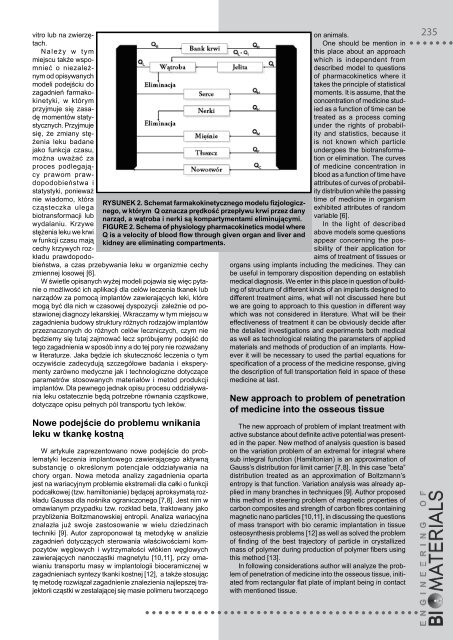89-91 - Polskie Stowarzyszenie Biomateriałów
89-91 - Polskie Stowarzyszenie Biomateriałów
89-91 - Polskie Stowarzyszenie Biomateriałów
Create successful ePaper yourself
Turn your PDF publications into a flip-book with our unique Google optimized e-Paper software.
vitro lub na zwierzętach.<br />
Należy w tym<br />
miejscu także wspomnieć<br />
o niezależnym<br />
od opisywanych<br />
modeli podejściu do<br />
zagadnień farmakokinetyki,<br />
w którym<br />
przyjmuje się zasadę<br />
momentów statystycznych.<br />
Przyjmuje<br />
się, że zmiany stężenia<br />
leku badane<br />
jako funkcja czasu,<br />
można uważać za<br />
proces podlegający<br />
prawom prawdopodobieństwa<br />
i<br />
statystyki, ponieważ<br />
nie wiadomo, która<br />
cząsteczka ulega<br />
biotransformacji lub<br />
wydalaniu. Krzywe<br />
stężenia leku we krwi<br />
w funkcji czasu mają<br />
cechy krzywych rozkładuprawdopodobieństwa,<br />
a czas przebywania leku w organizmie cechy<br />
zmiennej losowej [6].<br />
W świetle opisanych wyżej modeli pojawia się więc pytanie<br />
o możliwość ich aplikacji dla celów leczenia tkanek lub<br />
narządów za pomocą implantów zawierających leki, które<br />
mogą być dla nich w czasowej dyspozycji zależnie od postawionej<br />
diagnozy lekarskiej. Wkraczamy w tym miejscu w<br />
zagadnienia budowy struktury różnych rodzajów implantów<br />
przeznaczonych do różnych celów leczniczych, czym nie<br />
będziemy się tutaj zajmować lecz spróbujemy podejść do<br />
tego zagadnienia w sposób inny a do tej pory nie rozważany<br />
w literaturze. Jaka będzie ich skuteczność leczenia o tym<br />
oczywiście zadecydują szczegółowe badania i eksperymenty<br />
zarówno medyczne jak i technologiczne dotyczące<br />
parametrów stosowanych materiałów i metod produkcji<br />
implantów. Dla pewnego jednak opisu procesu oddziaływania<br />
leku ostatecznie będą potrzebne równania cząstkowe,<br />
dotyczące opisu pełnych pól transportu tych leków.<br />
rysunek 2. schemat farmakokinetycznego modelu fizjologicznego,<br />
w którym Q oznacza prędkość przepływu krwi przez dany<br />
narząd, a wątroba i nerki są kompartymentami eliminującymi.<br />
figure 2. schema of physiology pharmacokinetics model where<br />
Q is a velocity of blood flow through given organ and liver and<br />
kidney are eliminating compartments.<br />
nowe podejście do problemu wnikania<br />
leku w tkankę kostną<br />
W artykule zaprezentowano nowe podejście do problematyki<br />
leczenia implantowego zawierającego aktywną<br />
substancję o określonym potencjale oddziaływania na<br />
chory organ. Nowa metoda analizy zagadnienia oparta<br />
jest na wariacyjnym problemie ekstremali dla całki o funkcji<br />
podcałkowej (tzw. hamiltonianie) będącej aproksymatą rozkładu<br />
Gaussa dla nośnika ograniczonego [7,8]. Jest nim w<br />
omawianym przypadku tzw. rozkład beta, traktowany jako<br />
przybliżenia Boltzmanowskiej entropii. Analiza wariacyjna<br />
znalazła już swoje zastosowanie w wielu dziedzinach<br />
techniki [9]. Autor zaproponował tą metodykę w analizie<br />
zagadnień dotyczących sterowania właściwościami kompozytów<br />
węglowych i wytrzymałości włókien węglowych<br />
zawierających nanocząstki magnetytu [10,11], przy omawianiu<br />
transportu masy w implantologii bioceramicznej w<br />
zagadnieniach syntezy tkanki kostnej [12], a także stosując<br />
tę metodę rozwiązał zagadnienie znalezienia najlepszej trajektorii<br />
cząstki w zestalającej się masie polimeru tworzącego<br />
on animals.<br />
One should be mention in<br />
this place about an approach<br />
which is independent from<br />
described model to questions<br />
of pharmacokinetics where it<br />
takes the principle of statistical<br />
moments. It is assume, that the<br />
concentration of medicine studied<br />
as a function of time can be<br />
treated as a process coming<br />
under the rights of probability<br />
and statistics, because it<br />
is not known which particle<br />
undergoes the biotransformation<br />
or elimination. The curves<br />
of medicine concentration in<br />
blood as a function of time have<br />
attributes of curves of probability<br />
distribution while the passing<br />
time of medicine in organism<br />
exhibited attributes of random<br />
variable [6].<br />
In the light of described<br />
above models some questions<br />
appear concerning the possibility<br />
of their application for<br />
aims of treatment of tissues or<br />
organs using implants including the medicines. They can<br />
be useful in temporary disposition depending on establish<br />
medical diagnosis. We enter in this place in question of building<br />
of structure of different kinds of an implants designed to<br />
different treatment aims, what will not discussed here but<br />
we are going to approach to this question in different way<br />
which was not considered in literature. What will be their<br />
effectiveness of treatment it can be obviously decide after<br />
the detailed investigations and experiments both medical<br />
as well as technological relating the parameters of applied<br />
materials and methods of production of an implants. However<br />
it will be necessary to used the partial equations for<br />
specification of a process of the medicine response, giving<br />
the description of full transportation field in space of these<br />
medicine at last.<br />
new approach to problem of penetration<br />
of medicine into the osseous tissue<br />
The new approach of problem of implant treatment with<br />
active substance about definite active potential was presented<br />
in the paper. New method of analysis question is based<br />
on the variation problem of an extremal for integral where<br />
sub integral function (Hamiltonian) is an approximation of<br />
Gauss’s distribution for limit carrier [7,8]. In this case ”beta”<br />
distribution treated as an approximation of Boltzmann’s<br />
entropy is that function. Variation analysis was already applied<br />
in many branches in techniques [9]. Author proposed<br />
this method in steering problem of magnetic properties of<br />
carbon composites and strength of carbon fibres containing<br />
magnetic nano particles [10,11], in discussing the questions<br />
of mass transport with bio ceramic implantation in tissue<br />
osteosynthesis problems [12] as well as solved the problem<br />
of finding of the best trajectory of particle in crystallized<br />
mass of polymer during production of polymer fibers using<br />
this method [13].<br />
In following considerations author will analyze the problem<br />
of penetration of medicine into the osseous tissue, initiated<br />
from rectangular flat plate of implant being in contact<br />
with mentioned tissue.<br />
235













